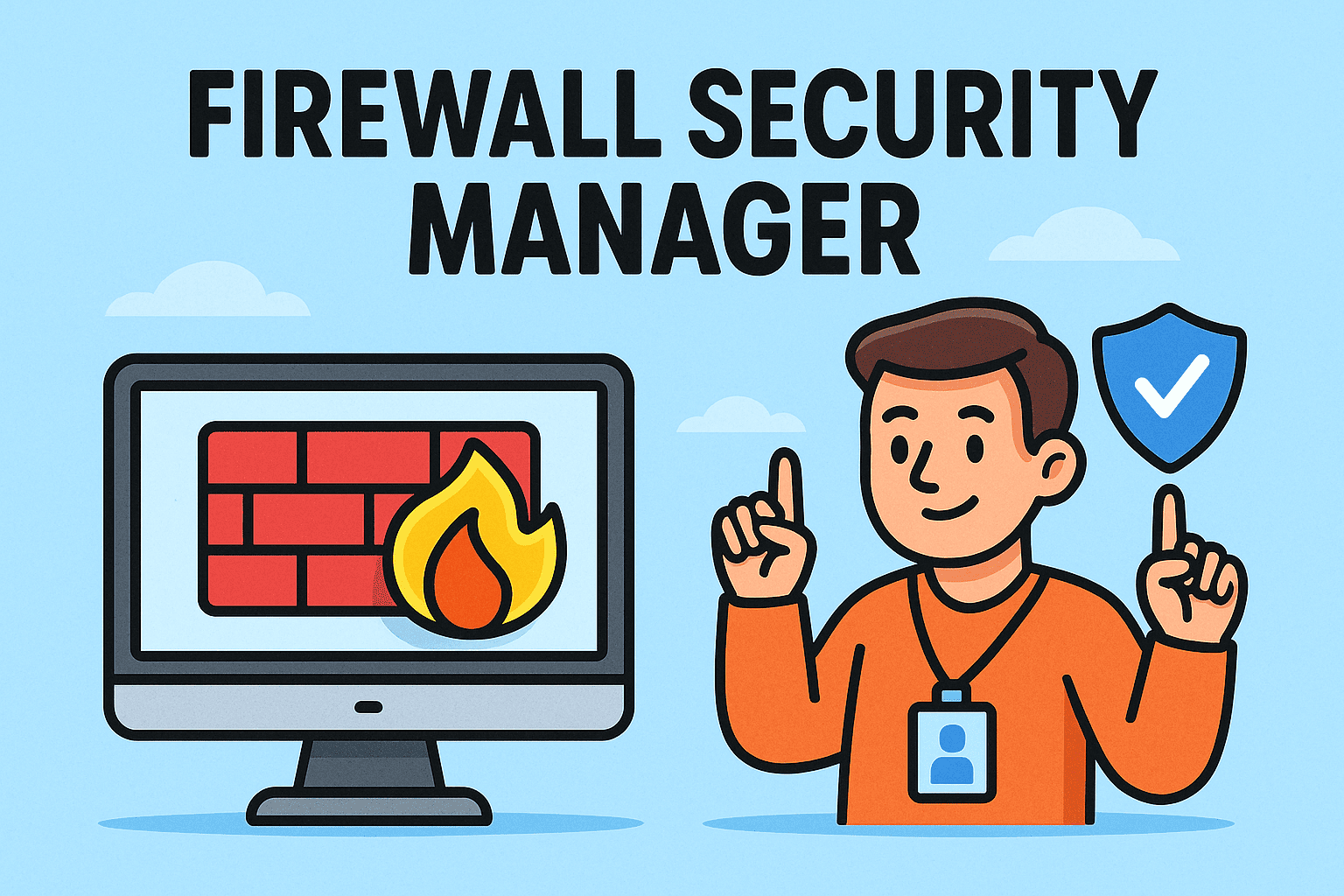Updated on October 7, 2025, by OpenEDR
Did you know that over 60% of businesses experienced attempted cyber intrusions via network vulnerabilities in the past year? As cyberattacks grow more sophisticated, traditional firewalls alone aren’t enough. The question is: how do IT managers and CEOs maintain full visibility and control over complex firewall environments?
Introduction: Why Firewall Management Is Critical Today
The answer lies in a firewall security manager. This tool centralizes the monitoring, configuration, and policy enforcement of firewalls across enterprise networks. For cybersecurity leaders, a firewall security manager ensures compliance, efficiency, and stronger protection against evolving threats.
What Is a Firewall Security Manager?
A firewall security manager is a centralized platform that helps organizations manage multiple firewalls, streamline security policies, and monitor traffic in real-time. Instead of configuring devices one by one, IT teams use this solution to unify and simplify firewall administration.
Core Functions:
Centralized Management – Oversee multiple firewalls from one dashboard.
Policy Control – Create, deploy, and monitor consistent security rules.
Real-Time Monitoring – Detect unusual traffic or attempted breaches.
Compliance Support – Ensure adherence to standards like PCI DSS, HIPAA, or GDPR.
Automation – Reduce manual errors by automating rule creation and updates.
👉 In simple terms: A firewall security manager acts as the control tower for your network’s perimeter defense.
Why Businesses Need a Firewall Security Manager
Modern enterprises face complex IT environments—cloud platforms, remote users, and hybrid infrastructure. Managing firewalls individually is inefficient and risky.
Key Benefits:
Improved Security Posture – Detect and respond to threats faster.
Operational Efficiency – Reduce manual tasks with automation.
Policy Consistency – Avoid gaps or overlaps in firewall rules.
Regulatory Compliance – Maintain auditable logs and reports.
Scalability – Support growing IT environments with centralized management.
For CEOs and IT managers, this means better protection, cost savings, and peace of mind.
Core Features of a Firewall Security Manager
When selecting a firewall management solution, enterprises should look for the following features:
1. Centralized Dashboard
Gives IT managers a unified view of all firewall devices and their statuses.
2. Automated Policy Management
Simplifies rule creation and updates, reducing human error.
3. Traffic Analysis & Reporting
Generates detailed reports on bandwidth usage, threats, and anomalies.
4. Compliance Management
Helps organizations prepare for audits with regulatory-ready reports.
5. Integration with Other Security Tools
Connects seamlessly with SIEMs, intrusion detection systems, and endpoint security.
Firewall Security Manager vs. Traditional Firewalls
Many organizations still rely on standalone firewalls. Here’s how they compare:
| Feature | Traditional Firewall | Firewall Security Manager |
|---|---|---|
| Deployment | Individual devices | Centralized platform |
| Policy Enforcement | Manual, per device | Automated, consistent |
| Threat Visibility | Limited | Real-time, holistic |
| Compliance Reporting | Manual and time-consuming | Built-in automation |
| Best For | Small networks | Medium to large enterprises |
👉 Verdict: A firewall security manager is essential for organizations with complex or growing network infrastructures.
Security Risks Without a Firewall Security Manager
Operating without centralized firewall management can expose organizations to:
Configuration Errors – Inconsistent policies create vulnerabilities.
Delayed Incident Response – Lack of real-time visibility slows containment.
Compliance Failures – Missing logs or reports can lead to fines.
Resource Strain – IT staff overwhelmed by manual monitoring.
In today’s fast-paced threat landscape, these risks can directly impact business continuity and reputation.
Best Practices for Implementing a Firewall Security Manager
To maximize benefits, IT leaders should follow these best practices:
Standardize Firewall Policies – Create templates for consistent application.
Automate Where Possible – Use automation to reduce manual errors.
Conduct Regular Audits – Review policies for redundancy or outdated rules.
Integrate with Security Ecosystem – Ensure compatibility with SIEM, EDR, and SOC workflows.
Train Staff – Educate teams on interpreting reports and managing alerts effectively.
Firewall Security Manager in a Zero Trust Framework
As enterprises adopt Zero Trust Security, firewall security managers play a crucial role:
Enforcing least privilege access across networks.
Continuously validating user/device identity.
Monitoring traffic in real-time to detect anomalies.
Supporting segmentation of workloads across hybrid environments.
The Future of Firewall Security Management
Cybersecurity is evolving, and firewall security managers are keeping pace with:
AI-Driven Threat Detection – Using machine learning to spot anomalies.
Cloud-Native Integration – Managing firewalls across multi-cloud deployments.
Automated Compliance – Real-time reporting aligned with regulations.
Predictive Analytics – Forecasting attack patterns before they occur.
For organizations, adopting these innovations will ensure resilience against next-generation cyber threats.
FAQs: Firewall Security Manager
1. What is the role of a firewall security manager?
It centralizes firewall management, policy enforcement, and monitoring for stronger cybersecurity.
2. How does a firewall security manager improve compliance?
By automating logs, audits, and reporting aligned with regulatory standards.
3. Is a firewall security manager necessary for small businesses?
Smaller companies may not need one, but it’s essential for medium to large enterprises with complex networks.
4. Can a firewall security manager stop ransomware?
It can help block entry points and detect unusual traffic, but it should be combined with endpoint security.
5. What is the difference between a firewall and firewall security manager?
A firewall protects a single network, while a firewall security manager oversees and optimizes multiple firewalls enterprise-wide.
Conclusion: Why Firewall Security Managers Are Essential
So, what is a firewall security manager? It’s more than a convenience tool—it’s a strategic necessity for modern enterprises. By centralizing control, automating policy enforcement, and improving visibility, it enables IT managers and CEOs to stay ahead of cyber threats while ensuring compliance and operational efficiency.
In a world where cyberattacks are increasing daily, firewall security management is no longer optional—it’s critical for business survival.
👉 Take your cybersecurity to the next level: Register for OpenEDR Free
